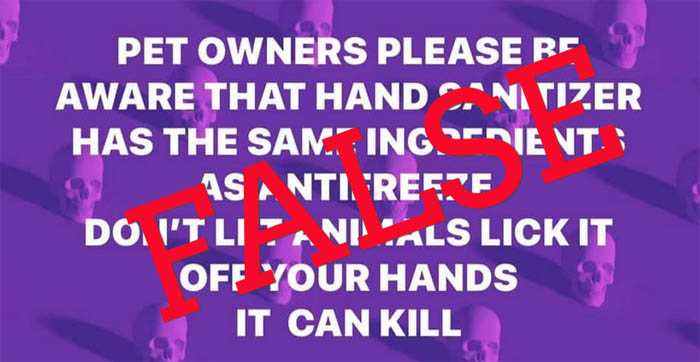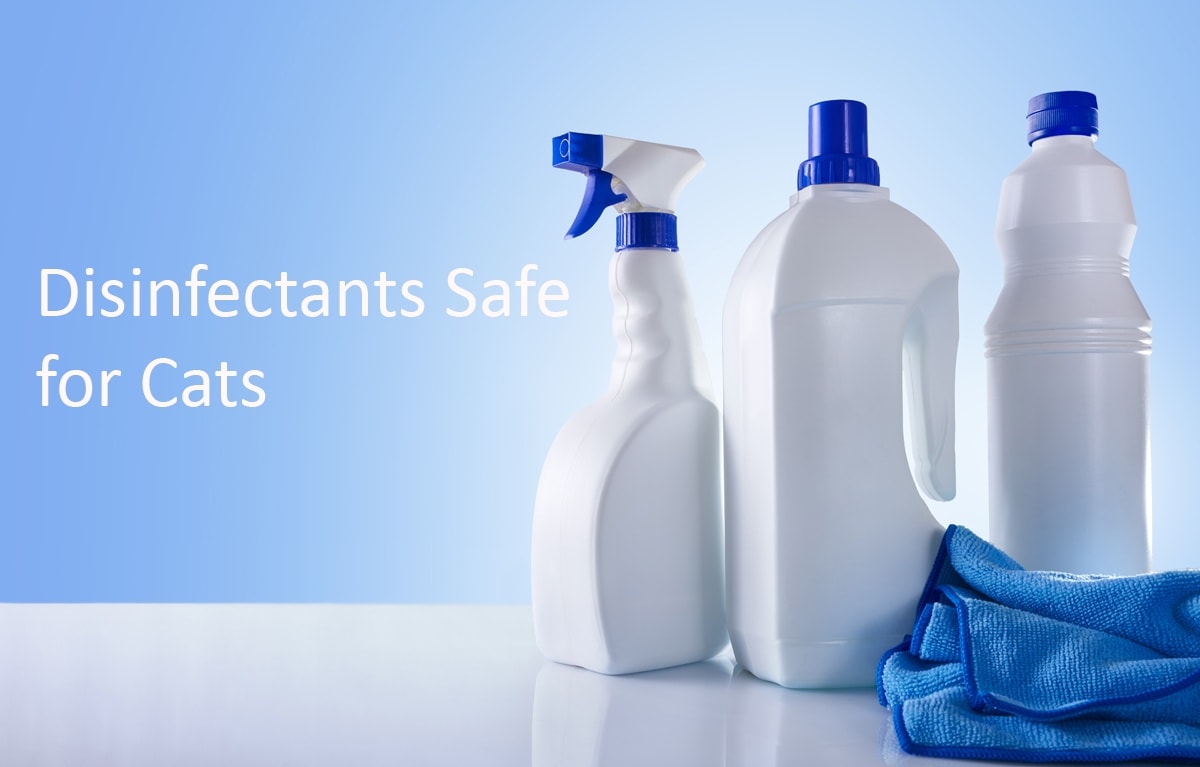What are disinfectants?
Disinfectants are chemicals for use in the home to kill microorganisms (viruses, bacteria, fungi and protozoa) on surfaces and equipment such as kitchen benches, floors and cooking equipment. They are an essential part of feline husbandry and help to keep cats and people safe from potentially dangerous pathogens.
There is no single product or method which can kill all microorganisms. Some may be susceptible to chemicals, others need heat to kill them (for example protozoal oocysts).
Risks from using the wrong disinfectant include poisoning by ingestion, inhalation and chemical burns.
Cats come into contact with chemicals in the home, which they can ingest during grooming. Many households have potentially dangerous products not realising how toxic they can be to cats.
Do not use
|
|
| Phenols (Dettol, Pine O Cleen, Pine-Sol) | Disinfectants which contain phenols are highly toxic to cats as they lack UDP-glucuronosyltransferase (UGT) enzymes, including UGT1A6 and UGT1A9 necessary to metabolise phenols. Do not use any product which turns white in water. |
| Essential oils | Many essential oils, especially tea tree oil are toxic to cats for the same reason as above (many essential oils contain phenols). Cats lack the necessary glucuronosyltransferase (UGT) enzymes necessary to metabolise the compounds. |
Use with caution
|
|
| Hypochlorites (chlorine) | Commonly referred to as bleach or chlorine, hypochlorites are safe in low concentrations, readily available, low-cost and have broad antimicrobial activity. Sodium hypochlorite is lethal towards most vegetative bacteria and viruses, endospore-forming bacteria, protozoa and fungi tend to be less susceptible. Chlorine gas is toxic to cats (and humans), as well as concentrated (>10%) chlorine, which can cause corrosive injury, hypernatremia, hyperchloremia, and/or metabolic acidosis. Most bleach products contain sodium hypochlorite (5-6%) and can be used to disinfect. The dilution differs depending on the pathogen, but most commonly is 1 part sodium hypochlorite to 32 parts water. Other hypochlorites include calcium hypochlorite and sodium dichloroisocyanurate.
Caution: Fumes can be irritating so ensure ventilation is adequate. Don’t mix bleach with other chemicals. |
Safe
|
|
| Veterinary disinfectants |
These products are used in veterinary practices, catteries, and shelters. Some are available to buy online, from your veterinary surgery or local pet shop. Caution: Always follow the manufacturer’s instructions. |
| Ethanol | Between 70-90% concentration for 1 minute. Higher concentrations are more effective.
Caution: Allow to dry before cats have access to the treated area. |
| Heat and steam | Heat is one of the most broad-spectrum disinfection methods, especially moist heat under pressure. Steam cleaners can clean surfaces, floors and soft furnishings. The temperature and length of exposure play a vital role in killing microorganisms with heat. Temperatures should reach 121°C (250°F) and 132°C (270°F), washing machines should be set to at least 60°C. Steam clean soft furnishings. |
Natural disinfectants
Natural products have a place in the home. White vinegar is great to clean kitchen benches, where food is prepared. But when it comes to actual disinfecting, I use bleach (on hard surfaces) or the dishwasher for utensils that have come into contact with raw meat. Most natural cleaners will not be effective in killing pathogenic microorganisms in the event of an outbreak of a disease that requires thorough decontamination in an environment such as a shelter or veterinary surgery or to clean litter trays.
Most natural cleaners will not be effective in killing pathogenic microorganisms in the event of an outbreak of a disease that requires thorough decontamination in an environment such as a shelter or veterinary surgery or to clean litter trays.
| White vinegar | Acetic acid (household vinegar) can work with several microbes, there is a lack of information regarding its effectiveness against viruses, particularly strains which affect cats. |
| Citric acid | Another great and natural household cleaner, citric acid can reduce Listeria monocytogenes but is not effective against most pathogenic organisms. |
| Hydrogen peroxide | With so many uses, hydrogen peroxide (6-7%) is a must in the home. I am not sure I would use it if I had a serious outbreak of disease, but it seems out of the natural disinfectants, this hydrogen peroxide does have antimicrobial effects against a number of organisms. |
| Sodium bicarbonate | Safe, available and low-cost. Sodium bicarbonate inactivates feline calicivirus but is not effective against E. coli O157, Salmonella Typhimurium and Listeria Monocytogenes. |
How to disinfect
Disinfecting with hypochlorite (bleach)
Remove dirt from the area before you apply disinfectant organic matter (dirt, hair, food, feces, litter) will inactivate most disinfectants. Scrub with hot soapy water.
A dilution of 1:32 is for bleach, although this may vary depending on the pathogen. For ringworm, it is 1:10. Use cold water when mixing bleach as hot water decomposes the active ingredient, making the product ineffective.
Leave the bleach solution on the surface for ten minutes. Thoroughly rinse with clean water.
Other disinfectants:
- Read the instructions: Always follow the manufacturers (or your veterinarian’s) instructions in regards to usage and dilution. Each product is different.
- Remove organic material: Clean the area with water and detergent before disinfecting. Remaining organic matter (dirt, hair, food, feces, litter) inactivates most disinfectants which makes them ineffective.
- Allow to dry or rinse off the product: Where instructed, allow disinfectants to dry before your cat is allowed to come into contact with them. Other types of disinfectant will need to be rinsed off. Always follow instructions to establish the contact time required.
- Cleaning soft furnishings: Soft furnishings such as bedding and blankets should also be disinfected if they can’t be disposed of. The best method is to wash small furnishings such as cat beds in the washing machine, on a hot cycle. Air dry in full sun or add a safe disinfectant to a mister and spray, allow drying before allowing your cat contact.
- Storage: Store disinfectants in a cool, dark and safe place out of reach of children and cats.
Is hand sanitiser toxic to cats?

A recent social media post claims that hand sanitisers contain ethylene glycol, the same ingredient in antifreeze which is highly toxic to cats. This is not true, most hand sanitisers contain ethyl alcohol (ethanol), which is the same alcohol found in alcoholic beverages.
Ethanol is toxic to cats (and humans), but the risk of toxicity from hand sanitisers is low. Most of us apply a squirt to our hands and rub it in, by the time our hands are dry (within seconds), the ethanol has evaporated.
Toxicity could occur if the cat deliberately ingested hand sanitiser, but this is unlikely due to the taste. As always, take care and store hand sanitisers out of reach of cats, and if a spillage occurs, clean up immediately.
Wash your hands after touching packages as COVID-19 can live for several hours to several days on surfaces.
Safety
- Remove all cats from the room while disinfecting and where possible open windows as many disinfectants can cause irritation to the airways and eyes in closed rooms.
- Wear safety goggles and rubber gloves when disinfecting to protect the eyes and skin.
- Never mix disinfectants unless instructed to do so. Some can become extremely toxic when mixed.
- Allow floors and surfaces to dry completely before allowing your cat to come into contact with them.
- Remember too to replace cat products such as litter trays every year or so. As they become worn, small scratches develop which can be a great way for bacteria to reside.
Frequently asked questions
What is the difference between antiseptics and disinfectants:
Antiseptics are applied to living tissue such as skin, disinfectants are used on non-living objects such as floors, walls, kitchen benches and litter trays. This article is about disinfectants, for antiseptics safe to use on cats, read here. Never use disinfectants on cats.
Different pathogens require different disinfectants, no disinfectant can kill all pathogens. Bleach (see below) is a good all-around disinfectant when used carefully, but even that has its limitations. If you are dealing with an outbreak always speak to your veterinarian about the most effective disinfectant.
Parasitic worm eggs are resistant to bleach but can be killed with extreme heat from steam or fire.
Why disinfect?
Pathogenic microorganisms can spread via direct contact (coughing, sneezing, mating, grooming), and fomites (inanimate objects such as food bowls, clothing, utensils). Disinfection of fomites and the environment help to prevent or stop the spread of disease.
Many pathogens quickly die once outside the body, but some, such as parvovirus (responsible for panleukopenia) and ringworm can live for months or even years in the environment, calicivirus can survive for up to a month and cause infection in cats exposed to the virus in the environment.
- Shelters, boarding catteries, and veterinary surgeries have a greater need to disinfect than households as they have a high turnover of animals who are often stressed or sick (in the case of veterinary surgeries and shelters).
- If you have an outbreak of an infectious disease or parasite which can infect cats, humans or other pets, disinfecting the environment will be necessary.
- Disinfect litter trays weekly.
- If you have an immunocompromised cat or person living in the house.
- An outbreak of a contagious human disease (such as COVID-19).
Is Dettol safe for cats?
No, Dettol contains phenol chloroxylenol which is toxic to cats.
Are Lysol wipes toxic to cats?
Yes, Lysol wipes contain phenol chloroxylenol.
Is Glen 20 safe to spray around cats?
Glen 20 spray contains ethanol which the cat may inhale if the product is used close to the cat and can also cause irritation to the eyes.
What cleaners are safe to use in a home with cats?
Natural cleaning products are preferable over commercial products, which include white wine vinegar, citric acid and bicarbonate of soda.
What antiseptics are safe for cats?
Antiseptics are antimicrobial products applied to the skin and disinfectants are used to kill microbes on objects and surfaces. Betadine and chlorhexidine are both safe to use on cats.
Which disinfectants are effective against covid?
The World Health Organisation recommends the use of 0.05% sodium hypochlorite (NaClO) and ethanol products (at least 70%) to disinfect surfaces in homes with suspected or confirmed Covid exposure. As always, remove organic debris and dry before applying disinfectant. The recommended dilution rate for sodium hypochlorite is (1 part of 5% strength household bleach to 49 parts of water).

